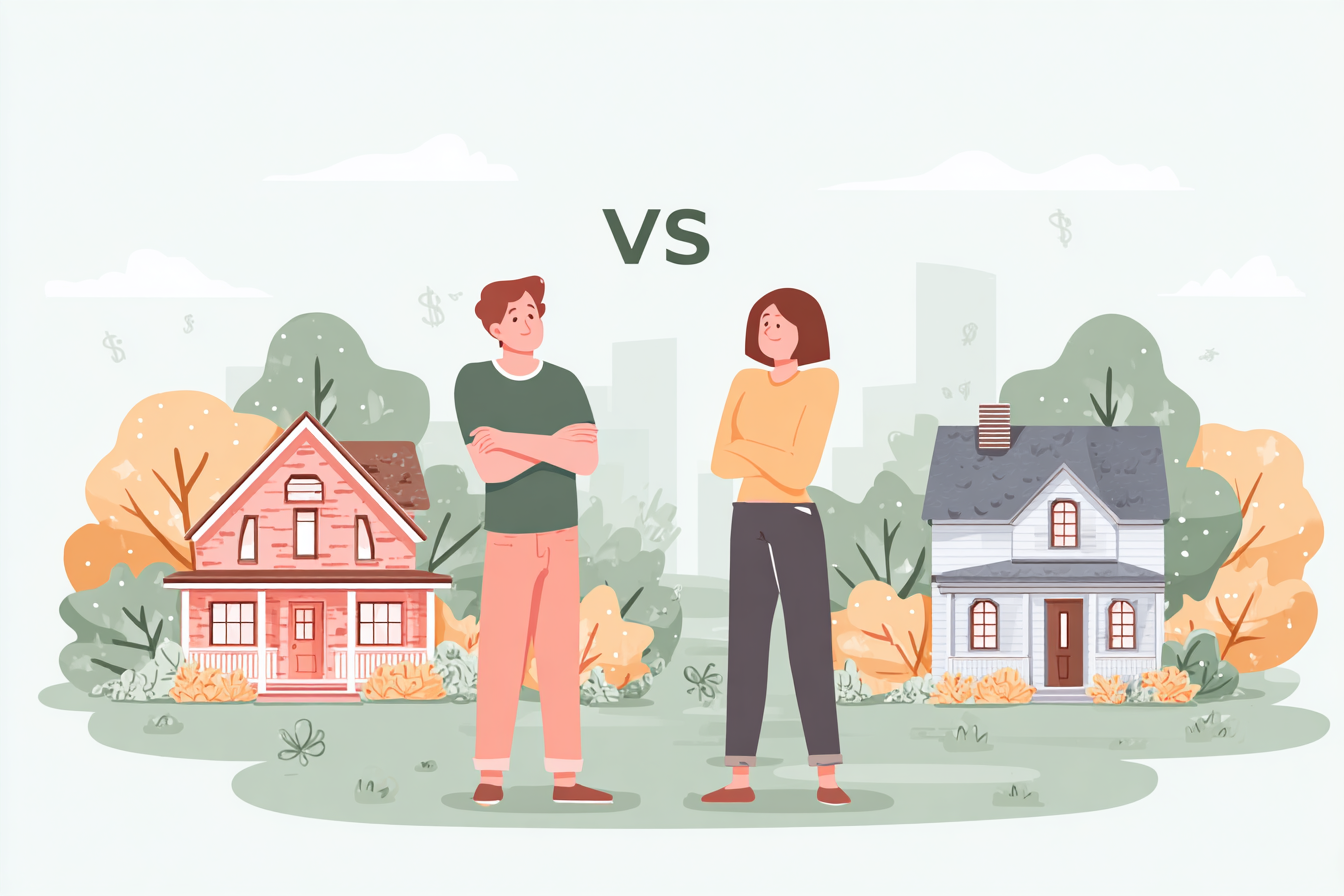Buying your first home? Congratulations! As a first-time borrower, you might be wondering how to compare different mortgage loan offers and pick the best one. Mortgage terms can seem overwhelming at first, but don’t worry, we’ll break them down in simple terms. By understanding key factors such as interest rates, APR, loan types, fees, and other relevant details, you’ll feel confident in choosing a mortgage that suits your needs. In this friendly guide, we’ll walk you through what to look for in each loan offer and include a side-by-side comparison of three offers to illustrate how it all comes together.
Interest Rate vs. APR: What’s the Difference?
One of the first things you’ll notice on any mortgage offer is the interest rate. This is the percentage that determines the annual interest rate on your loan. However, there’s another important number: the APR (Annual Percentage Rate). The APR represents the total cost of the loan per year, including not just interest but also certain fees and charges.
- Interest Rate: Think of this as the base cost of borrowing the money. It’s used to calculate your monthly principal and interest payment. For example, a 6.5% interest rate means you’ll pay 6.5% of the loan balance per year in interest, not counting any extra fees.
- APR: The APR is typically slightly higher than the interest rate, as it includes fees such as points, lender origination charges, mortgage insurance, and other loan costs. In short, APR provides a broader view of the loan’s total cost, making it useful for comparing offers. By law, lenders must disclose the APR so that you can compare loans on an apples-to-apples basis.
Which one matters more? Both are important. The interest rate is crucial for your monthly payment (since your payment is calculated from the interest rate, not the APR). The APR is key to understanding the overall cost of the loan over time. When comparing loan offers, consider the APR to determine which loan might cost you less in total.
Additionally, examine the interest rate to understand your monthly payment. For example, one loan might have a lower interest rate but higher closing fees (making its APR higher), while another loan has a slightly higher rate but no fees.
Bottom line: Check both numbers and understand why they differ.
Fixed-Rate vs. Adjustable-Rate Mortgages (ARM)
Next up: what kind of interest rate are you dealing with? Mortgages generally come in two flavors – fixed-rate and adjustable-rate.
- Fixed-Rate Mortgage: With a fixed-rate loan, the interest rate is locked in for the entire life of the loan. It never changes. Your monthly principal and interest payment will remain the same from day 1 to year 30. This stability makes budgeting easier; there are no surprises because of rate changes.
- Adjustable-Rate Mortgage (ARM): With an ARM, the interest rate can change over time after an initial fixed period. Typically, an ARM starts with a lower initial rate for a set time (say, 5 years), which means lower payments at first. After that, the rate can adjust periodically (often once a year). If rates rise in the market, your ARM’s rate and monthly payment may increase, sometimes significantly. If rates decrease, your rate could also decrease (although some ARMs have limits on adjustments).
How do you decide? Consider your plans and risk tolerance. If you plan to stay in your home for a long time or simply prefer a predictable payment, a fixed-rate might be better; you won’t have to worry about future rate hikes. If you expect to move or refinance in a few years, or you’re comfortable with some uncertainty, an ARM could save you money in the short term with its lower initial rate. Just don’t assume you can refinance or sell before the rate adjusts; life happens, and you should be prepared for the possibility of higher payments if you keep the loan beyond the initial period. Always look at the ARM’s terms: How often can it adjust, what’s the maximum rate (rate cap), and what’s the “worst-case” payment if rates spike?
When comparing a fixed-rate offer with an ARM, consider comparing their APRs, but remember that the APR on an ARM doesn’t reflect future rate increases; it’s calculated using the initial rate only. Be cautious with ARMs and ensure you understand the details.
Loan Term: 15-Year vs. 30-Year Mortgages
Another significant factor is the loan term – the length of time you have to repay the loan. The two most common terms are 30-year and 15-year. This choice has a huge impact on your monthly payment and the total interest you’ll pay:
- 30-Year Mortgage: The most popular choice for many first-time buyers. Because you’re paying off the loan over a longer period (360 months), monthly payments are lower than they would be on a shorter term. However, you’ll pay more interest over the life of the loan, and the interest rate itself is usually a bit higher than on a 15-year loan.
- 15-Year Mortgage: This loan is paid off in half the time (180 months). Monthly payments are higher – sometimes almost double – because you’re repaying the principal much faster. The benefit is that lenders often offer a lower interest rate on 15-year loans, and you’ll pay far less interest overall. In fact, a 30-year mortgage can end up costing substantially more in interest than a 15-year loan for the same amount borrowed.
Which is right for you? If you can comfortably afford the higher monthly payment, a 15-year mortgage can save you a lot of money in interest and help you build equity faster. But if the 15-year payment would stretch your budget too much, a 30-year loan offers breathing room with a lower payment.
Points and Lender Credits
When you see an interest rate quote, check if it assumes you’re paying points or receiving lender credits. These options allow you to adjust the balance between your upfront costs and ongoing interest rates.
- Discount Points: Often referred to simply as “points,” these are an upfront fee paid at closing to lower your interest rate. One point equals 1% of the loan amount (for example, 1 point on a $200,000 loan = $2,000). By paying points, you pay more at closing but get a lower interest rate in return. This means a lower monthly payment and less interest paid over the life of the loan. Points can be a good deal if you plan to keep the mortgage for a long time, long enough to recoup that upfront cost through the lower payments. When comparing offers, one lender might offer a 6% rate with zero points, while another offers 5.75% but with 1 point. You’ll need to decide if the lower rate is worth the extra upfront cost. The APR can help here – a loan with points will have a higher upfront cost but a lower rate, and its APR reflects all that.
- Lender Credits: This is the opposite of points. With lender credits, the lender gives you money to help cover closing costs, but in exchange, you accept a higher interest rate. Essentially, you pay less (or even nothing) at closing, which is great for your wallet today, but you’ll have a higher monthly payment and pay more interest over time. For example, a lender might say: “We can offer a credit of $3,000 toward your closing costs if you take a rate that’s 0.25% higher.” If you’re cash-strapped for the down payment and fees, lender credits can help reduce the upfront burden, just realize the trade-off is a higher APR (since your interest rate is higher).
There’s no free lunch: whether you pay points or take credits, it shifts cost from now to later or vice versa. Tip: Be cautious with slogans like “no closing cost loan.” That usually means the lender is just using credits to cover the costs; you’ll be paying through a higher rate instead. It’s not that fees disappear; they’re just baked into the rate. Always ask the lender: “What rate is that with no points? What if I pay 1 point? What if I want no closing costs?” They can show you options. Then decide which option aligns with your financial situation (pay upfront vs. over time).
Closing Costs and Fees

Every mortgage comes with closing costs, which are the fees and expenses you must pay to finalize the loan. When comparing loan offers, consider comparing the closing costs as well, not just the interest rate. Closing costs typically range from approximately 2% to 5% of the loan amount and cover a variety of services and charges. Here are some common closing costs (don’t worry, you’ll get an itemized list in your Loan Estimate document):
- Origination Fee: A fee charged by the lender for processing and originating the loan (basically, for doing the paperwork and approving your mortgage). This may also include application or processing fees. It’s the lender’s way of getting paid for creating the loan.
- Underwriting Fee: This covers the cost of the lender’s underwriting process, which involves evaluating your creditworthiness and assessing the risk associated with lending to you. Sometimes this is lumped together with origination or listed separately.
- Appraisal Fee: The cost of hiring a professional appraiser to assess the value of the home. The lender requires this to ensure the home is worth at least what you’re paying (and what they’re lending). As the borrower, you will pay for the appraisal as part of the closing costs.
- Title Insurance and Title Search: Fees for a title search (to make sure the title is clear of liens or issues) and title insurance to protect you and the lender in case there’s an error in the title records. These are often third-party costs and can vary depending on the location.
- Other Fees: Additional fees may include credit report fees, flood certification fees, attorney or closing agent fees, and recording fees (paid to the local government for recording the mortgage), among others. Your Loan Estimate will list all of them.
When comparing offers, pay attention to the total closing costs, but also be aware of which fees can vary by lender. Third parties set some costs for the government (such as appraisal, taxes, and recording fees), which will be similar regardless of the lender. The ones mostly within the lender’s control are things like origination or underwriting fees, as well as any “points” or “credits” discussed above. For example, one lender might charge a $1,000 origination fee, while another charges $500 – that could make a significant difference. Review the Loan Estimate each lender provides: Page 2 of the Loan Estimate includes a breakdown of closing costs. Sections A (origination charges) and B (services you can shop for) are often the areas where lenders differ. Section E (taxes and government fees) or certain fixed expenses should be similar; if one estimate shows those much lower, it might be an assumption rather than a real difference (and you shouldn’t pick a lender just because they guessed lower taxes!).
Tip: Calculate the “cash to close,” which is the total amount of cash you need on hand at closing (down payment + all closing costs minus any credits). This is also listed on page 2 of the Loan Estimate. Ensure you’re comfortable with the number for each offer. If one loan requires significantly more cash to close (maybe due to points or higher fees), that’s a factor to consider.
Down Payment Requirements
Your down payment, how much you pay upfront toward the home’s price, can actually vary between loan offers or loan types. Different lenders and loan programs have varying minimum down payment requirements. For example, a conventional loan might require as little as 3% down for first-time buyers, while FHA loans require at least 3.5%. Additionally, some lenders may require a down payment of 5% or more for certain programs. If you have a specific down payment in mind, ensure the offers you compare are based on the same down payment for an apples-to-apples comparison.
Why does the down payment matter for comparing loans? A larger down payment usually means you’re borrowing less and you’re seen as a lower-risk borrower. This can help you secure a better interest rate or more favorable terms. If you can put 20% down (or more), that’s kind of a magic number: not only might you get a slightly lower rate, but you also avoid private mortgage insurance (PMI) (more on PMI next), and you start with more equity. Generally, the more you put down, the less you pay in interest overall, as your loan amount is smaller and your rate may be slightly lower.
On the flip side, if you put down less than 20%, most lenders will require you to pay PMI. Some loan offers might be structured for, say, 10% down or 5% down, which is great if you don’t have 20% saved, but you’ll need to factor in the extra cost of PMI in your monthly payment. Additionally, a lender may offer a slightly lower interest rate, for example, with 15% down versus 20% down. Sounds odd, right? That can happen because with 15% down, you’re paying PMI, which actually protects the lender. The lender might be willing to shave a small amount off the rate since you’re paying insurance for their benefit. However, even if such an offer has a lower rate, it could still be more expensive overall once you factor in the PMI premiums. The lesson: look at the whole picture, including interest rate, PMI, and the amount you’re borrowing.
When comparing two offers, try to keep the down payment constant, if possible. If they’re different (maybe you’re considering one loan that’s 5% down FHA vs one that’s 10% down conventional), be sure to note how that affects your upfront cash, the need for PMI, and your equity. Also, check if the lender has any down payment assistance options or special programs for first-time buyers – those could influence the offer. However, always ensure you can comfortably afford the down payment required when selecting a loan.
Private Mortgage Insurance (PMI)
Let’s discuss PMI further, as it can be a significant factor in loan comparisons for first-time buyers. Private Mortgage Insurance is an insurance policy that you (the borrower) pay for, but it protects the lender in case you stop making payments. Lenders generally require PMI if your down payment is less than 20% of the home’s value. In other words, if you’re borrowing more than 80% of the home’s value, PMI is typically required.
What does PMI mean for you? It’s an extra monthly cost on top of your mortgage payment. The amount can vary, but it may be anywhere from 0.2% to 1% (or more) of the loan amount per year, depending on your down payment and credit score.
Your Loan Estimates will show the monthly mortgage insurance cost if applicable. PMI does not go toward paying off your mortgage principal; it’s just an insurance premium. The good news is that it won’t last forever. Once you have about 20% equity, you can usually cancel PMI (by reaching 80% LTV on your original schedule or through requesting earlier cancellation if your home value has increased). Some loans (like FHA loans) have their own mortgage insurance rules, but for a standard conventional loan, expect to pay PMI until you hit that equity milestone.
When comparing loan offers, be aware of which ones include PMI and factor that into your decision.
In short, PMI is not evil; it enables you to buy a home with less than 20% down, which is fantastic if you haven’t saved a huge sum. However, it is a cost, so be sure to take it into account. If one offer requires PMI and another doesn’t, that could tilt the decision. And remember, once you can, you’ll want to cancel PMI to drop that extra cost. Until then, just treat it as part of the price of homeownership with a low down payment.
Prepayment Penalties and Other Loan Terms
Most standard home loans these days do not have prepayment penalties; however, some may, especially certain refinancing loans or non-conforming loans. A prepayment penalty is basically a fee that the lender can charge if you pay off your loan early (either by refinancing, selling the home, or making large principal payments above a certain amount). It’s meant to compensate the lender for the interest they would have earned if you had stuck to the full term. For example, a loan might say “2% prepayment penalty if the loan is paid off in the first 3 years.” That means if you suddenly paid off the remaining balance (say via refinance or cash), you’d owe an extra 2% of that balance as a fee.
When comparing offers, review the fine print to determine if a prepayment penalty applies. This will be listed on the Loan Estimate (page 1, under Loan Terms). It will ask, “Prepayment Penalty?” and provide options of “Yes” or “No” along with the terms. Ensure it is set to “No” or, if “Yes,” understand the details. As a first-time buyer, you’ll generally want a loan without such penalties, because you want the freedom to refinance or pay extra if circumstances allow. Many conventional loans are free of prepayment penalties nowadays, but some loans (like certain adjustable-rate or “non-QM” loans) might have them. If one offer has a prepayment penalty and another doesn’t, that’s a mark against the one that does (unless the rate is substantially lower and you’re certain you won’t need to pay it off early – but predicting the future is hard!).
Also consider other loan terms or features: Is there an interest-only period (unlikely for a first-time buyer loan, but worth considering)? Is the loan assumable? (This matters more for future buyers of your home.) Does the loan include any balloon payment (which is now rare in standard loans)? Most of these won’t apply if you’re looking at typical 15- or 30-year fixed or standard ARMs. However, it’s a good idea to skim the Loan Estimate and ask the lender questions. Always ask questions if something is unclear or if one offer has a feature you don’t understand. Lenders should explain any unusual provisions.
Monthly Payment Estimates and Your Budget
At the end of the day, one of the most important questions is: “How much is this loan going to cost me each month?” All the factors mentioned above contribute to your monthly mortgage payment. When comparing offers, make sure you compare the monthly payment estimates for each loan and understand what’s included in that number.
A typical monthly mortgage payment (often called “PITI”) has up to four parts: Principal, Interest, Taxes, and Insurance. Principal and interest (P&I) are the components that go to your loan repayment. Then, you may have insurance, which can include homeowner’s insurance and mortgage insurance (PMI), if applicable, and property taxes, which may be collected in an escrow account as part of your monthly payment. When lenders provide a monthly payment estimate, they often quote the total payment, including escrowed taxes and insurance, to give you a realistic picture of the cost of homeownership. However, remember that the lender does not set property taxes and homeowner’s insurance – they are what they are for the home, regardless of who your lender is. So, if Lender A’s estimate shows $100 less per month in taxes than Lender B’s, that doesn’t mean Lender A is offering a better deal – it might just mean they estimated taxes differently. Focus on the loan-related portions of the payment: principal, interest, and mortgage insurance. Those are what differ between loan offers.
Compare the principal & interest (P&I) payments for each loan, as the loan amount, term, and interest rate directly determine them. Then add in PMI if one loan has it and another doesn’t. For example, if Offer 1 has a $1,200 P&I and no PMI, and Offer 2 has a $1,150 P&I but $100 PMI, then Offer 2’s total monthly outgo (excluding taxes/HOI) is $1,250 – actually higher. Don’t let a slightly lower interest rate fool you if it comes with PMI or a higher loan balance. Also, check if the estimates include homeowner’s insurance and property taxes. Those should be roughly the same for the same house, but lenders might use different estimates. You can ask each lender for clarification or use your own realistic estimates to compare.
In short, when you line up the offers, ask: “What will my monthly payment be with this loan, and what does that include?” Make sure you’re comparing the same components. It can be helpful to create a spreadsheet or write down the following information for each offer: the loan amount, interest rate, term, monthly principal & interest, monthly PMI (if applicable), and any other monthly charges (such as HOA dues, if applicable, but these are outside the scope of the loan). That way, you see the full picture.
Comparing Three Mortgage Offers: An Example
To bring all these factors together, let’s walk through a simple example. Imagine you are buying a $250,000 home. You speak with three lenders and receive three loan offers. Here’s a side-by-side comparison of Offer A, Offer B, and Offer C:
| Factor | Offer A (30-yr Fixed) | Offer B (30-yr Fixed) | Offer C (30-yr Fixed) |
| Interest Rate | 6.5% (fixed) | 6.0% (fixed) | 6.5% (fixed) |
| APR | 6.7% | 6.2% | 6.8% |
| Loan Term | 30 years | 30 years | 30 years |
| Down Payment | 20% ($50k) | 20% ($50k) | 5% ($12.5k) |
| Points Paid | 0 points | 1 point ( ~$2,000) | 0 points |
| Closing Costs | ~$5,000 | ~$7,000 (higher due to point) | ~$5,000 |
| Loan Amount | $200,000 | $200,000 | $237,500 (higher loan; low down) |
| Monthly P&I | ~$1,264 | ~$1,199 | ~$1,422 |
| PMI | No PMI | No PMI | Yes – ~$90/month |
| Estimated Total Monthly(P&I + PMI) | ~$1,264 | ~$1,199 | ~$1,512 |
Let’s interpret this comparison:
- Offer A has a 6.5% interest rate and no points. Since you’re putting 20% down, there’s no PMI. The monthly principal & interest come out to about $1,264. Closing costs are around $5,000 (which includes typical fees but no points). The APR is 6.7%, slightly higher than the 6.5% rate, reflecting the $5k in fees. This is a pretty standard 30-year fixed scenario.
- Offer B has a lower interest rate at 6.0%, which looks attractive. However, this rate comes with one discount point paid upfront (about $2,000). That increases the closing costs to ~$7,000. Due to this point, the APR (6.2%) is higher than the 6.0% rate, but still lower than the APR of Offer A. The monthly P&I is about $1,199, saving you roughly $65 a month compared to Offer A. Offer B might be a good choice if you have the extra cash now and plan to stay in the home long enough to gain from the lower monthly payment (it would take about 2.5 years to break even on the $2,000 point, given $65/month savings). If you leave or refinance before that, paying the point may not be worth it. However, in the long run, Offer B would cost less per month and incur slightly less interest overall than Offer A due to its lower rate.
- Offer C maintains the same interest rate as A (6.5%) but requires only 5% down payment. That means your loan amount is much higher – you’re borrowing $237,500 instead of $200,000. Because the down payment is less than 20%, you have PMI of approximately $90/month. The monthly principal & interest on the larger loan is about $1,422, and when you add PMI, the effective payment is around $1,512. That’s significantly higher per month than the other two offers – even though the interest rate is the same as Offer A – simply because you’re financing a larger portion of the home and have PMI. The APR is 6.8%, slightly higher than Offer A’s, which may reflect the potential for an upfront mortgage insurance premium or the same fees spread over a smaller down payment. Closing costs are listed similarly to A (~$5k), assuming no points and similar fees (PMI typically does not affect closing costs, except possibly an upfront premium on some loans, such as FHA). Offer C’s advantage is the significantly smaller upfront cash to close (you only need $ 12,500 plus closing costs, versus $50k plus closing costs for the others). This could be the difference between buying a home now and waiting if you don’t have a full 20% saved. However, the trade-off is a higher ongoing cost.
Which would you choose? It depends on your priorities:
- If monthly affordability is your main concern and you have the savings, Offer B gives the lowest monthly payment due to the lower rate (thanks to that point).
- If minimizing upfront costs is key (perhaps you need to conserve cash for renovations or emergency fund), Offer C lets you buy with a low down payment – but you’ll pay more each month until you can drop PMI.
- Offer A is a middle-ground: no PMI, no points – a solid option if you want to avoid PMI but don’t want to pay extra points.
This example illustrates how you must consider all factors together: interest versus APR, upfront cost versus monthly cost, and how factors such as points or PMI influence the numbers. Everyone’s situation is different. Some borrowers might value the lowest possible monthly payment because their monthly budget is tight; others might want to minimize long-term cost and don’t mind paying extra upfront.
Making Your Decision
When you have multiple Loan Estimates from different lenders, take the time to compare them line by line. Don’t hesitate to ask each lender questions like:
- “Why is your APR higher/lower than your competitor’s for the same loan type?”
- “Are you charging any points? Is there an option with zero points or with more points at a lower rate?”
- “What are your total origination or lender fees? Can those be reduced or waived?”
- “Does this loan have any PMI or other monthly fees? When can PMI be removed?”
- “Do you charge a prepayment penalty or any unusual fees?”
Remember, you can negotiate too. If you prefer one lender (for instance, they have great customer service or you trust them), but another is offering a slightly better rate or lower fee, let them know. Often, lenders will match or beat a competitor’s offer to earn your business. The mortgage market is competitive.
Empower yourself with knowledge, ask questions, and trust your math. With a clear understanding of these factors, you’re ready to choose a mortgage offer that works for you and start your homeownership journey on the right foot!
You might also be interested in: A Guide to Refinancing Your Mortgage: Pros, Cons, and How to Get Started






